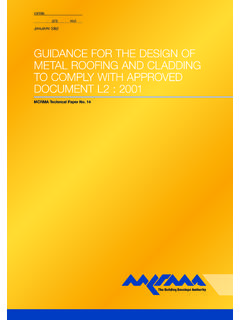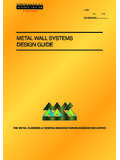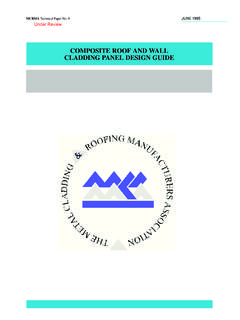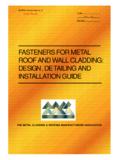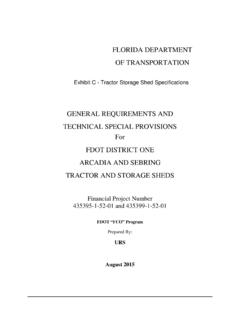Transcription of Metal Fabrications: Design, Detailing And …
1 Metal FABRICATIONS: design , Detailing ANDINSTALLATION GUIDECI/SfBNh(47)DECEMBER 2006 MCRMA Technical Paper No. 11 REVISED EDITIONC ontents Introduction Glossary of terms design and specification 3 Laps/junctions 3 Fasteners 5 Sealants 6 Insulation and vapour control layer 6 Materials Architectural details 8 Introduction 8 Mitred flat panels 8 Mitred profile corners 9 Bull noses 9 Bull nose corners 9 Wings, fins and aerofoils 9 Window surrounds 9 Louvre systems 10 Curved fabrications 10 Fascia and soffit systems Manufacture Special requirements for aluminium 13 Allowance for expansion 13 design and installation 13 Sealants 14 Welding 14 Fasteners 14 Aesthetics Penetrations 15 Rubber gaskets 15 Profiled soakers 15 Apron fabrications 16 On-site weldings 16
2 On-site GRP 16 General Workmanship 17 Good housekeeping 17 Tools 17 Fasteners 18 Site measurement and setting out Problem-solving 19 The Metal Cladding & Roofing Manufacturers Association Limited. December 2006 For up to date information on Metal roof and wall cladding, including downloadable construction details in 3D, visit IntroductionNote: The following descriptions only apply in the context of Metal roofing and claddingApron fabrication A wide flat fabrication used to weather from the back of an opening back to a ridge or other interruption in the roof. An apron fabrication is at the same level as the top or crown of the roofing mouth The gaping of a lap strap Used to join two fabrications which butt together, usually closure fabrication A shape of fabrication that does not nest and therefore cannot be 1 Closed fabricationsFabrication/trim/closer/clos ure Any component used to close the roof or wall to a junction or Thickness of Developed width of a seam A method of jointing material to form a curved 2 Lock-form seamLongitudinal edge The long edge of a canning Slight deformation occurring to wide flat fabrication facesOpen fabrication A shape of fabrication that purpose of this design guide is to establish the basic principles behind the successful design , Detailing and installation of fabrications in profiled Metal roofs and walls.
3 Much attention is paid in design to the Metal roof or wall construction and the basic shape of fabrications however; the vital junctions and fixings etc and the appearance of fabrications can be overlooked and are often left to the experience of the fixer on site. In fact, on many buildings it is the fabrications that the user of the building will notice first, particularly on curved roofs. Complaints to roofing contractors and manufacturers concerning leakage are mainly due to fabrications, either in design or indifferent guide addresses aspects of steel and aluminium fabrications and workmanship, together with special applications such as GRP soakers or on-site welding. It does not deal with the shape of a fabrication to suit a particular junction but with the jointing and use of the fabrication itself. While aluminium fabrications are referred to throughout the guide, the particular requirements for aluminium are discussed in section with any engineering problem there is always more than one solution to a fabrication design and a multitude of opinions about the correct methods.
4 MCRMA has endeavoured to present the optimum solutions and the best practice from a wide variety of sources and where there are choices, the merits of each one is Glossary of termsWelt A shape formed into the edge of a sheet to provide a stiffer edgeFig 6 Different welt shapes A tight 180 welt. Lockform welt. One half of form of welt used to lock two sheets of Metal together. Can provide a flatter surface on fixing. Open welt. An open 180 degree welt. Stiffened edge or lip. Edge angled by 30 or returned on itself by 150 .Fig 3 Open fabricationsPitch Either the slope of a roof, or the spacing of fixings Fixings used to secure the fabrication to the structure or abutting Metal - blind sealed A rivet with a closed bulb; can have a neoprene/EPDM 4 Blind (sealed) rivetRivet Bulbtite/TLR. A proprietary type of rivet with expanding legs and a neoprene/EPDM 5 TLR/Bulbtite rivetSecondary fixings Fixings used across endlaps to compress the A fabricated Metal or GRP component which forms the transition from the profiled sheet to the screws Fasteners with a specially modified thread designed to fix thin sheets together and incorporating an integral coloured A shallow bend within a flat area to stiffen a wide a sample prior to volume manufacture and that the sample be retained on site for future reference.
5 If at all possible the sample should be installed in the building, including a joint, and offered to the design team for comment or 7 Closed steel fabrication : butt joint, single lines of sealantFig 8 Open steel fabrication : lap joint, single sealant strip (steel)Fig 9 Welded butt strap on aluminium bullnose show twin Laps/junctionsLap joints form the simplest joint in open shape flashings. Lap joints in closed shape fabrications that do not nest easily can bird mouth . In these cases, butt straps of 150mm minimum designed to fit within the fabrication are needed. To enable a flashing to lap well, any welt or lip should be trimmed off the length of the lap. Lap joints on sloping flashings for example, verges should be formed to overlap the width of a fabrication should be kept to the minimum that can be achieved practically to reduce the vulnerability to foot traffic and end laps are conditions where fabrications can be open jointed provided that they are not required to perform a weathering function.
6 Examples are features or bullnoses installed either outside the building line or over previously weathered required to provide weathering should have a double run of sealant applied either side of the line of fasteners or a wide channel shaped seal through which the fastener can be installed. This must be used with care to prevent winding of the sealant around the straps should be designed and fabricated to take into account sealant modulus (neutral cure) silicone sealants can be over compressed within joints when fasteners are installed which results in a seal that will not perform in the long term when movement occurs. If such sealants are to be employed, spacers should be used to ensure that a minimum gap of approximately 6m is achieved. Preferably, these joints should be sealed using an NFRC Class A butyl strip large unsupported flat areas over 200mm wide should be avoided if possible unless stiffening folds can be the appearance of fabrications is important, factory-fabricated corners and junctions should be used.
7 It is also prudent that aesthetically sensitive items should be subject to the architect s approval design and Specification100-150mmbutt strap75-100mmbetween fixingsSingle sealant stripsSecondaryfixingPrimaryfixing150mmS ealant450mm betweenprimary fixingsSealantFixing at eachend of arcFactory welded butt strapCurved aluminium bullnoseFig 12 Lap joints show double sealant runsLap joint, single or double sealant strip(steel)Steel butt joint or unfixed lap with movement allowed at each joint to avoid thermal movement accumulating in a long length. Low modulus neutral cure silicone sealant is one suitable sealant. Fasteners should be stainless steel rivets or lap joint, wide sealant strip. Some sealant strips can make drilling the hole for the fixing more awkward by binding the butt strap, single or double sealant strip to each butt strap, single wide sealant strip each 10 Open steel fabrication : lap joint single line of sealant show twin sealsSummary Minimum lap 150mm on roofs, 100mm on walls Only open fabrications that nest should be lapped; use butt straps with closed fabrications Minimum butt strap length 150mm Butt straps should fit within the fabrication profile with an allowance for sealant thickness Stitch laps at 75-100mm centres Position the first line of sealant on the weatherside of the jointStop fascia fabrication butt straps at the lower shadow line to prevent water tracking around the gap at the butt strap onto the wall.
8 Pointing the gap at a butt strap with clear silicone for example, is not recommended because the silicone can pick up dirt and any smears soon become 11 Fascia fabrication butt strap4150mm (roof)100mm (wall)Primary fixing 450mmSingle sealant strip75-100mmPrimary fixingat max. 450mm c/cLip removed forlength of lapStep joint openButt strap behindjoint, no masticin gapFall150 mm (Roof) 100 mm (Wall)Optional double sealant50 mm minFall150 mm (Roof) 100 mm (Wall)Fall150 mm butt strap3 mmFall3 mmOptional double sealant150 mm (Roof) 100 mm (Wall)3 mm150 mm (Roof) 100 mm (Wall) the fastener heads are visible and require colour matching, this may be achieved by stitcher screws with factory-moulded integral colour heads or coloured rivets. Push-on caps do not normally provide a long-term colour match and are prone to becoming detached.
9 The choice of stitcher fixing may be influenced by the final appearance desired as they have larger heads than rivets and are more 15 Rivets and are available in a variety of materials. Self-drilling stitcher screws are available in carbon steel, austenitic stainless steel and aluminium. For coated steel fabrications, the choice between carbon and stainless steel will depend upon the environment (both external and internal) and the desired lifespan. For aluminium fabrications, austenitic stainless steel or aluminium stitchers should be sealed rivets for fabrications are available with aluminium or stainless steel bodies with either aluminium, carbon steel or stainless steel type rivets are usually all aluminium and their design with the clamping legs provides excellent 13 Typical verge/ridge (mono) junction: lap joint, single line of join two thin materials together and must be purpose-designed for the application.
10 These are generally either self-drilling stitcher screws with bonded sealing washers and integral caps, blind sealed rivets or proprietary Bulbtite/TLR sealed rivets. Colour caps should be avoided as they do not have long-term durability. Where stitcher screws are selected, then the fastener should have a free-spin zone behind the washer to pull the two fabrications together. Stitcher screws in some applications can lead to a bulky across a lap or butt joint need to clamp and hold the two surfaces together, and also firmly compress the sealant where applicable. This requires them to be installed at 75-100mm centres to avoid opening up under the load. Fabrications must be well secured to the structure or sheeting and maximum centres of 450mm (or alternate profile crowns, whichever is the closer) are recommended see figure 14.

